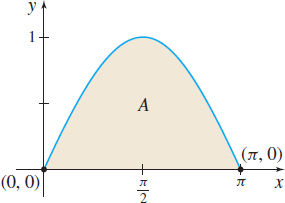EXAMPLE 6Using Property (5) of Definite Integrals

Figure 27 f(x)=sinx,0≤x≤π.
- (a) Find an upper estimate and a lower estimate for the area A under the graph of f(x)=sinx from 0 to π.
- (b) Find the actual area under the graph.
Solution The graph of f is shown in Figure 27. Since f(x)≥0 for all x in the closed interval [0,π], the area A under its graph is given by the definite integral, ∫π0sinx dx.
(a) From the Extreme Value Theorem, f has an absolute minimum value and an absolute maximum value on the interval [0,π]. The absolute maximum of f occurs at x=π2, and its value is f(π2)=sinπ2=1. The absolute minimum occurs at x=0 and at x=π; the absolute minimum value is f(0)=sin0=0=f(π). Using the inequalities in (5), the area under the graph of f is bounded as follows:
The Extreme Value Theorem is discussed in Section 4.2, p 265.
0≤∫π0sinx dx≤π
(b) The actual area under the graph is A=∫π0sinxdx=[−cosx]π0=−cosπ+cos0=1+1=2 square units